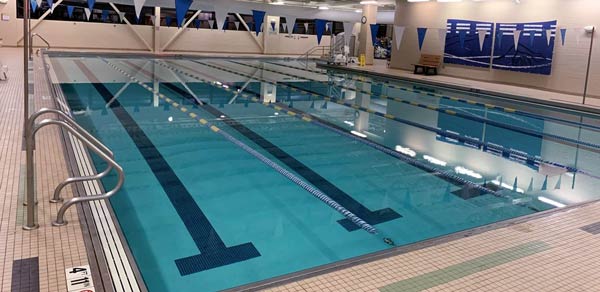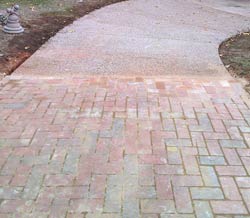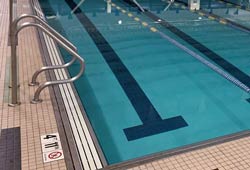
Preventing Slips, Trips and Falls
An ongoing challenge for most agencies is minimizing the risk of Slips, Trips and Falls (STF), a loss leader for PDRMA members. Here’s how two agencies addressed the issue at their facilities with the help of PDRMA resources.
Pleasure Driveway and Park District of Peoria
 As part of the 2019 Risk Management Review Pilot Group B, Peoria used the Kickoff Form to look at two major STF areas. “Our Golf Learning Center facility has an indoor driving range, which we set up and take down seasonally,” remembers Karrie Ross, Superintendent of Finance. “In 2018, an employee fell from a ladder while dismantling the range’s netting.” PDRMA Risk Management Consultants suggested swapping the traditional frame ladder for a platform ladder. As part of the 2019 Risk Management Review Pilot Group B, Peoria used the Kickoff Form to look at two major STF areas. “Our Golf Learning Center facility has an indoor driving range, which we set up and take down seasonally,” remembers Karrie Ross, Superintendent of Finance. “In 2018, an employee fell from a ladder while dismantling the range’s netting.” PDRMA Risk Management Consultants suggested swapping the traditional frame ladder for a platform ladder.
“We worked with facility employees to procure a platform ladder, and PDRMA covered our cost through the Ladder Reimbursement Program,” explains Ross. “We work very hard to avoid employee injuries, but if one occurs, we investigate the cause of the incident and make corrections and revisions to prevent it from happening again. In this instance, it was an added benefit to have PDRMA’s reimbursement program offset the expense of making this worksite safer.”
 She also points out the benefits of Risk Management Consultants spotting small changes in site conditions that occur over time. During one field walkthrough in 2018, they discovered some tripping hazards in the Lucy Botanical Garden outdoor walkway. “We saw two sections of the concrete and paved walkway had settled or heaved creating a trip hazard. Because of that, our maintenance staff releveled the pavers and poured cement patches to bring the walkways back to grade. We’re grateful we have the consultants working with us, because they’re the ‘fresh set of eyes’ that make our facilities safer.” She also points out the benefits of Risk Management Consultants spotting small changes in site conditions that occur over time. During one field walkthrough in 2018, they discovered some tripping hazards in the Lucy Botanical Garden outdoor walkway. “We saw two sections of the concrete and paved walkway had settled or heaved creating a trip hazard. Because of that, our maintenance staff releveled the pavers and poured cement patches to bring the walkways back to grade. We’re grateful we have the consultants working with us, because they’re the ‘fresh set of eyes’ that make our facilities safer.”
Park District of Highland Park
Slippery surfaces — especially wet ones — are another STF risk. But how do you determine when “slippery” is too slippery? The Park District of Highland Park found the answer through Coefficient of Friction Testing, another program PDRMA offers to members. The testing measures the degree of force that resists a sliding motion of one surface against another. Lack of slip resistance is what can cause a slip and fall — a circumstance commonly found around tile or concrete flooring, locker rooms, indoor pool decks and maintenance areas.
Mitch Carr, Director, Recreation and Facilities, Park District of Highland Park, recalls the agency qualifying to have the coefficient of friction testing done on its pool deck. “It was simple and not disruptive to our operations. It took no more than 10 minutes in each area, depending on the size of the area.”
 The test revealed the pool deck would benefit from a non-slip, tile-grip treatment, and the agency followed the recommendation, completing the work in December 2019. Although it’s too early to quantify improvements, Carr has high expectations the treatment will reduce slips and falls. “We’re replacing the deck in 2022 and will budget to apply this treatment on the new one as well.” The test revealed the pool deck would benefit from a non-slip, tile-grip treatment, and the agency followed the recommendation, completing the work in December 2019. Although it’s too early to quantify improvements, Carr has high expectations the treatment will reduce slips and falls. “We’re replacing the deck in 2022 and will budget to apply this treatment on the new one as well.”
Carr recommends contacting your risk management consultant to ask about participating in PDRMA’s program and doing the coefficient of friction testing. “It is a low-cost service to analyze your risk for slips and falls — but the cost to resolve the issues was significantly more than we anticipated. I would absolutely get several quotes and do your due diligence,” he suggests.
If PDRMA approves your agency’s participation in the Coefficient of Friction Testing Program, a qualified company will perform the test and provide a comprehensive report along with recommendations. You’ll also qualify for a $250 reimbursement from PDRMA for remediation. For more information on the Coefficient of Friction Testing Program, click here.
|

